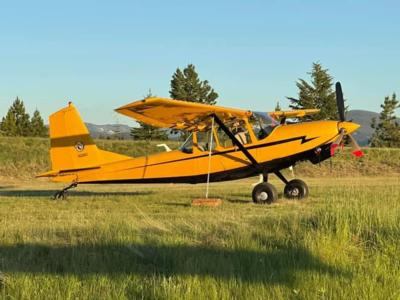"The Pilot’s Failure To Remove The Flight Control Lock Before Departure..."

E-I-C Note: Too many know-it-alls who seemed to think they were clairvoyant have had too much to say about this tragedy long before the Probable Cause report and actual evidence saw the light of day... and we're sick of it -- and we KNOW that many of Dale's loved ones feel likewise. SO... here is what the NTSB ultimately reported, without further comment.
Location: Lewiston, Idaho Accident Number: WPR21FA283
Date & Time: July 24, 2021, 11:52 Local Registration: N28U
Aircraft: SIAI-MARCHETTI SM-1019B Aircraft Damage: Substantial
Defining Event: Loss of control in flight Injuries: 1 Fatal
Flight Conducted Under: Part 91: General aviation - Personal
Analysis
The pilot was attempting an intersection takeoff about midfield when, shortly after the airplane became airborne, it pitched up aggressively, rolled left, and descended into the ground in a nose-down attitude.
Examination did not reveal any evidence of preaccident malfunctions or failures of the flight control system, and there was no evidence to indicate that the pilot’s seat had moved. Both the engine and propeller exhibited damage signatures consistent with high engine power at impact. The airplane was equipped with a flight control locking system that comprised a pivoting, Ushaped control lock tube mounted permanently to the rudder pedal assembly and a forwardfacing locking arm mounted to the pilot’s control stick. The control lock immobilized the aileron and elevator controls but still allowed for near-full movement of the rudder and tailwheel.

The cabin floor, where the control lock tube should have been mounted for flight, was severely deformed and compressed. Had the lock been stowed during impact, it would have been pinned under the flight control stick, crushed longitudinally, and its retaining clip would have been deformed; however, the control lock and its retaining clip were essentially undamaged, and the lock was found raised off the floor. The locking arm on the control stick also showed no evidence of deformation or impact damage but had rotated about 90° to the right of its normal position, as if forced into that position on impact while the control lock was still attached.
Given this information, it is likely that the control lock was installed on the flight control stick during takeoff and impact. High-resolution security camera footage of the accident revealed no discernable movement of the elevators or ailerons, further suggesting that the flight controls were immobilized by the control lock.
Although the control lock is painted red, its orientation when engaged results in the pilot viewing it directly down its length, at its narrowest profile. A pilot who owned a similar airplane stated that he had once become distracted during preflight checks and was able to taxi, initiate takeoff, and become airborne with the control lock engaged. He stated that, once he realized his mistake, removal of the lock was a struggle due to the forces imposed on the control stick during takeoff.

The pitch trim was found in an almost full nose-down position, suggesting that the pilot may have been attempting to use the trim to arrest the airplane’s increasing nose-up attitude due to the locked control stick. Whether the pilot recognized that the control lock was engaged or believed he had a flight control problem could not be determined. Regardless, after takeoff during a dynamic and transitional phase of flight, there would have been minimal time to accurately diagnose the issue and disconnect the control lock.
The intended purpose and destination of the flight was routine and there was no apparent time pressure present. The pilot was reported to be extremely thorough about performing preflight checks, and according to his wife, the expected duration of his normal preflight activities would not have allowed him to depart when he did. The pilot had limited experience in the accident airplane, which could explain why he did not remove the control lock during the preflight inspection. There was no video evidence to provide insight into the duration and scope of the pilot’s preflight inspection; however, omission of the preflight control check was uncharacteristic given his extensive flight experience, and the reason it was not performed could not be determined. While omission of the control check is consistent with a pilot rushing or distracted, and the short duration from taxi to takeoff would have reduced this pilot’s opportunity to detect his error, the investigation was not able to determine the
reason it was not performed. Had the pilot completed a functional check of the controls before initiating takeoff, the presence of the lock would have been detected and the accident would have been prevented.
Although the pilot’s autopsy demonstrated the presence of heart disease, which posed an increased risk of an impairing or incapacitating cardiac event, heart disease is unlikely to have caused inattention. It is also unlikely that the pilot was incapacitated by a cardiac event because his final radio transmission showed that he was aware and speaking after the onset of loss of control. Thus, it is unlikely that the pilot’s heart disease contributed to the accident.
Probable Cause and Findings
The National Transportation Safety Board determines the probable cause(s) of this accident to be: The pilot’s failure to remove the flight control lock before departure, which resulted in a loss of airplane control and impact with terrain. Contributing to the accident was his failure to perform an adequate preflight inspection and flight control check before takeoff.
 Airborne 05.10.24: Icon Auction, Drunk MedEvac Pilot, Bell ALFA
Airborne 05.10.24: Icon Auction, Drunk MedEvac Pilot, Bell ALFA ANN's Daily Aero-Term (05.13.24): ILS PRM Approach
ANN's Daily Aero-Term (05.13.24): ILS PRM Approach ANN's Daily Aero-Linx (05.13.24)
ANN's Daily Aero-Linx (05.13.24) Airborne-NextGen 05.07.24: AI-Piloted F-16, AgEagle, 1st 2 WorldView Sats
Airborne-NextGen 05.07.24: AI-Piloted F-16, AgEagle, 1st 2 WorldView Sats Airborne 05.08.24: Denali Update, Dad-Daughter Gyro, Lake SAIB
Airborne 05.08.24: Denali Update, Dad-Daughter Gyro, Lake SAIB





